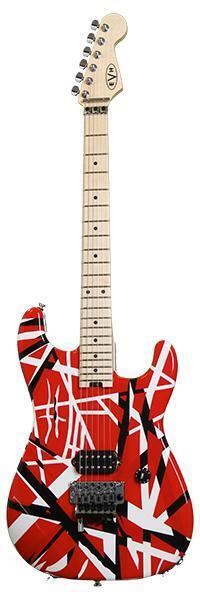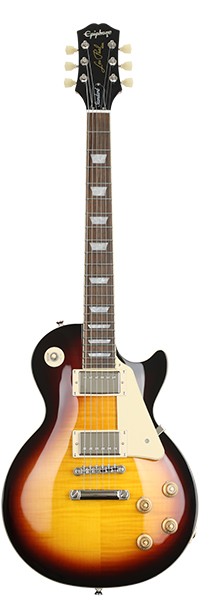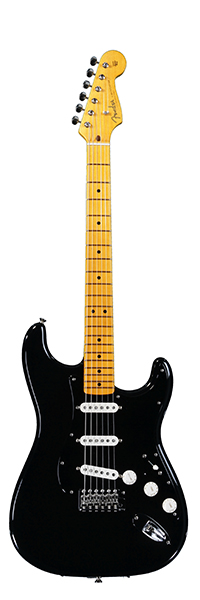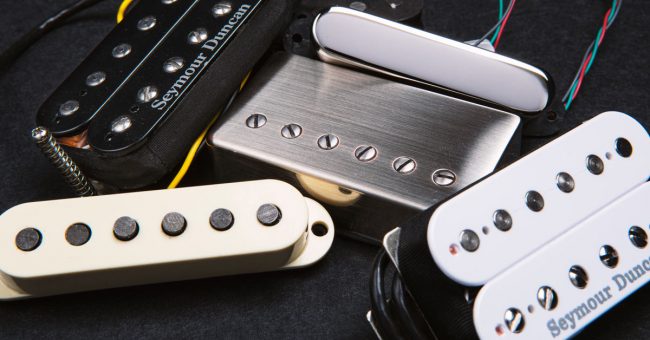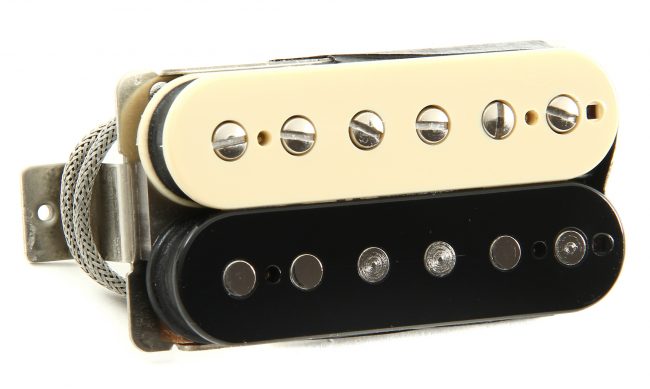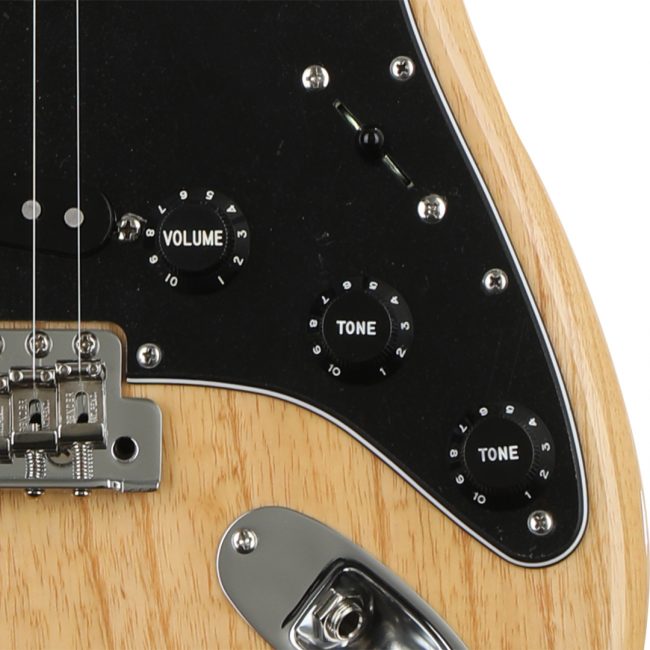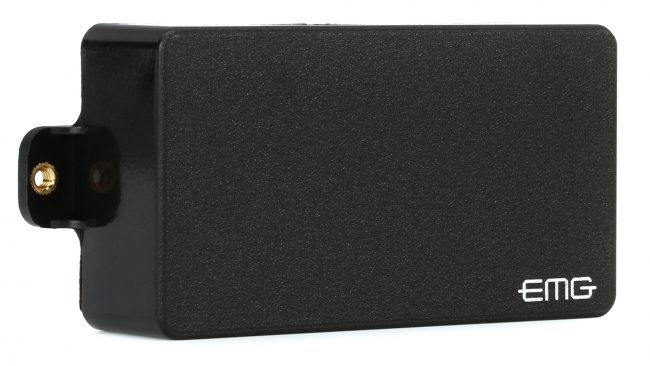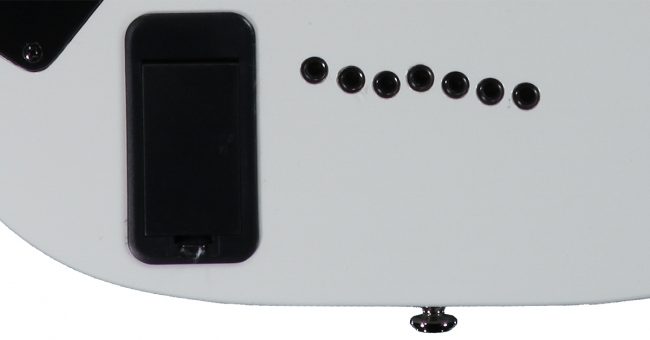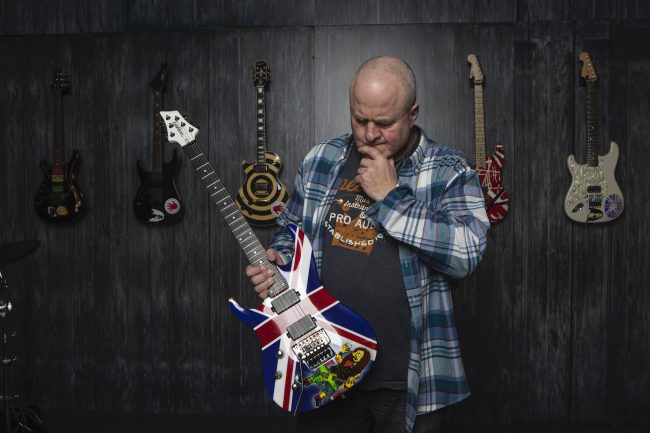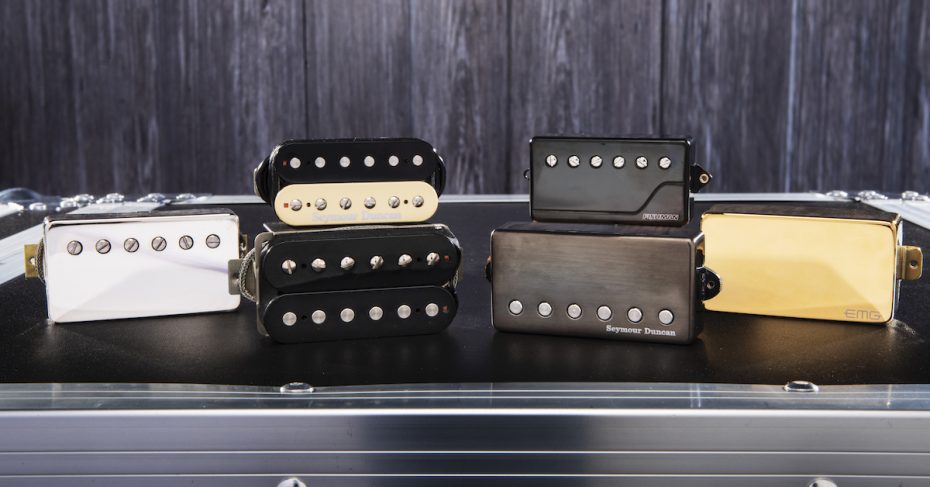
The best of both worlds — three popular passive pickups & three equally popular active ones.
“What’s the difference between active and passive pickups?” This is a question that pops up time and time again and will no doubt continue to do so for as long as there’s electricity. As for “which one is best for me?”; ultimately and ironically, the only person that can really answer that question is — wait for it — you! I say this because, while everyone and their brother will have an opinion, only your ears and your fingers will be able to truthfully tell you which one sounds and feels best to you.
What will help you, though, is having a basic understanding of the difference between these two basic pickup food groups. Being aware of the commonly voiced pros and cons for each of them will better arm you, too. So, that’s exactly what we’re going to talk about in this piece. To add even more insight, I’ve asked some of Sweetwater’s resident pickup experts for their thoughts, too. Hopefully this article will help shed some light on this oft-discussed and sometimes confusing subject. We’ll start at the very beginning by answering this simple question so we’re all on the exact same page from the get-go.
What’s a Pickup?
Simply put — a pickup is that rectangular-shaped (humbucker) or skinny-capsule-shaped (single-coil) hunk of plastic or metal that sits on your guitar’s body in the area between the bridge and the neck, directly below where you pick or strum the strings. Some guitars just have one (think Eddie Van Halen’s famous striped axes), but most have either two (think Gibson Les Paul, SG, or Flying V) or three (think Fender Strat).
One… two… three pickups.
As its name suggests, a pickup’s job is to literally “pick up” the vibrations of the guitar’s strings and then to transform them into an electric signal. This signal then goes through any pedals you may be using and into your amp before leaving the speaker(s) as amplified sound.
Tech Talk #1: Both pickups and speakers are types of transducer. What’s a transducer? It’s something that converts one type of energy into another type. The pickup converts the vibrations of your guitar’s strings into an electrical signal that goes to your amp. Then, once your amp has worked its magic on said signal, that amplified signal is converted back into sound waves via vibrations of the speaker cone.
To learn more about pickups, our Picking The Perfect Pickup article is a great place to start!
What’s a Passive Pickup & How Does It Work?
In a nutshell, passive pickups don’t need a source of electrical power in order for them to do their job — all the work is done by a clever combination of magnets and wire without the help of a battery. Passive pickups are the firstborn in the electric guitar kingdom and are, by far, the most common and most widely used. Invented in the early 1930s, the electromagnetic pickup basically consists of a permanent magnet wrapped with some kind of magnetic wire — typically copper. The magnet creates a magnetic field around the pickup and also magnetizes your electric guitar strings, as they all just so happen to be made of magnetic material (have you ever seen a Les Paul with nylon strings on it?!). So, when you pick a string, its vibrations create a moving magnetic field above the pickup’s wire coil. As a result of this movement, an electrical signal is induced in said coil — and so the tone games begin!
Tech Talk #2: You’ll often read something like this in a “how a passive electric guitar pickup works” article: “the string’s vibration ‘disturbs’ the pickup’s magnetic field and that’s what causes the coil to generate an electrical signal.” In truth (as opposed to lying!), that’s what I’d always thought was the deal, too — until I started digging deeper to ensure this article was as straightforward yet as accurate as I could possibly make it. Here’s what I discovered, and it comes straight from the brain of the often-overlooked Seth Lover — the clever chap who invented the world’s first-ever humbucking pickup, the legendary PAF (Patent Applied For), in 1955.
Here’s what this late, great man told replacement pickup maven, Seymour Duncan, in the late 1970s: “That’s the one thing people don’t understand. They figure that the string is waving there and cutting the [pickup’s] magnetic lines of force. Nuts. That isn’t it. The magnet — all it does is magnetize the string. Now you’ve got a waving magnetic field. And we have a fixed coil with a waving magnetic field to induce voltage. If you want to, take the magnet out. Once you’ve magnetized your string, it will play until the string loses it.”
New knowledge assimilated. Mind blown; back to the plot…
It should also be pointed out that, while there are countless different tonal and output offerings in the passive pickup world, even the hottest one out there doesn’t actually boost a frequency; it can only attenuate (reduce) the frequencies it, er, picks up… or leave them as they are, of course. That said, a particular passive pickup can, for example, give you more midrange than another one in the same exact guitar. How can it do that? It all comes down to how the pickup is made — the type of magnet; the strength of that magnet; the type of wire and insulation used; the number of wire turns made when the pickup is wrapped; how this winding is done — all these factors can have a dramatic effect on how the pickup sounds.
Nothing is “boosted” though — it’s effectively all down to selective attenuation. For example, a passive pickup that accents the midrange would reduce lows and highs with little or no attenuation in the mids, thus producing the desired midrange “bump.” This is obviously a simplified, layman’s (read: guitarist’s) view, but that’s the general gist. Geddit?
To this end, the tone controls on a guitar with passive pickups are also invariably passive — meaning they can only cut (attenuate) frequencies. So, if the tone control for your Les Paul’s or your Strat’s bridge pickup is all the way up, you’re not boosting the high end — you’re merely not cutting any of it! Make sense?
Tech Talk #3: This neat definition of the difference between an active and a passive electronic circuit from someone far smarter than me might well help illustrate this…
“Active circuits have energy-supplying components — such as a battery — in them, whereas passive circuits can only consume or preserve energy.”
Another thing worth being aware of is this: the electrical signal that a passive pickup produces is relatively small but plenty big enough to make its way out of your guitar, down your cable, and to the first thing that will make it bigger — be it a stompbox or your amp. The output signal from a passive pickup is also high impedance (high voltage, low current) — I’m pointing out this nerdy fact because it happens to have a couple of side effects that are sometimes considered negatives. All this will be revealed in the “Pros and Cons” section, so let’s move on.
What’s an Active Pickup?
As I’m sure you’ve already surmised (duh!), an active pickup is one that includes a preamp circuit that requires power — typically from a 9-volt battery or sometimes two — in order for it to work. No battery? No sound! That stated, the next logical question is…
How Does an Active Pickup Work?
Simply put, the heart of an active pickup is a very low-output passive pickup that works in the exact same way we’ve just discussed, except with a lot fewer windings. It still magnetizes the guitar strings, and when they vibrate, an electrical signal is induced in the coil. Due to the smaller number of coils though, the initial electrical signal is weaker than even a low-output, “regular” passive pickup. All is well, though, because it feeds an active circuit that boosts and shapes it via a preamp and various filters. The result is a low-impedance (low-voltage, high-current) signal that’s typically a lot “hotter” than even the “hottest” passive pickup while remaining much, much quieter.
It should be pointed out that, while active tone controls are available, the tone controls in your typical active pickup set are still passive — meaning they don’t boost, they merely attenuate (cut). Ditto for the volume pots.
The Main Event! Passive vs. Active
From my experience, this contest is a pretty polarizing one for a great many guitarists. They generally prefer one or t’other, and there’s often little middle ground. Players who prefer passive pickups are quick to aggressively attack active ones, and vice versa. One of the most common, stereotypical blanket statements frequently goes something like this: “Active pickups are too sterile sounding. They’re only good for metal players and guitars with skull inlays — that’s it!”
Hmmm. Granted, active pickups are indeed great for metal and have resulted in many classic albums that are anything but sterile sounding, IMHO. That said, my ultimate, two-word counter to that somewhat asinine assertion is this: David Gilmour! Yep, the man responsible for soulful solos such as “Comfortably Numb” has his own signature prewired EMG DG20 set — and the musical magic that man weaves is anything but metal and definitely not sterile! Other “definitely not metal” axemen spotted using active pickups include Larry Carlton, Steve Lukather, Vince Gill, and Mr. Gristle himself, Greg Koch… and there’s not a skull inlay to be seen on any of their fiddles!
Here are some of the common pros and cons of both types. Special thanks to some of my Sweetwater pickup savants for their input and insight on this.
Passive Pickup Pros
✔️ Very touch sensitive and responsive to picking and playing dynamics
✔️ Extremely “familiar” sounding, as they’re omnipresent on many classic guitars, hit songs, and albums
✔️ Popular in all genres of music — from blues and jazz to rock, pop, and metal
✔️ Generally more affordable than their active brethren
✔️ Some players describe them as being more “natural,” “organic,” or “woody” sounding
✔️ An almost mind-boggling amount of different outputs and tonal options to choose from
✔️ Very simple — electronically speaking
✔️ No need to find room for a darned battery or to reroute your beloved axe
✔️ No mid-gig, “is my battery OK?” concern
Passive Pickup Cons
❌ Susceptible to unwanted noise, especially single-coils, which are extremely prone to hum
❌ Feedback (of the unwanted kind!) can be an unwelcome issue
❌ Overwinding for higher output invariably reduces brightness, resulting in a powerful but somewhat dark and often muddy sound
❌ Their high-impedance output results in high-frequency loss when using long lengths of cable
❌ If you get one too close to your strings, especially a high-output passive, the sheer strength of its magnetic pull can have a detrimental effect on both tone and sustain… and even on intonation
Passive Pickup Pro & Con… huh?!?
✔️ & ❌ Their high-impedance output causes your tone to change when you turn down your guitar’s volume control. Some players consider this a minus — others consider it a plus!
Active Pickup Pros
✔️ Quiet
✔️ High output with tight low end and clear highs
✔️ Consistency in both the clean and crunch worlds
✔️ Low magnetic pull, so you can get it as close to your strings as you want without detrimental “pull” effects
✔️ Slightly more sustain as a result of the aforementioned low magnetic pull
✔️ Well-balanced tone that works well with effects pedals
✔️ Wider tonal response than passives
✔️ No loss of highs when long cables are used, thanks to their low-impedance output
✔️ Articulate
Active Pickup Cons
❌ Respond to pick and playing dynamics in a very different way than passives
❌ Not as “organic” or “warm” sounding to some players as passives
❌ Need a battery and a suitable place for it to be securely housed; plus, if screws are involved, changing one mid-gig is a nightmare
❌ A low battery can have a less-than-desirable impact on your sound
❌ More expensive than passives
Active Pickup Pro & Con… huh #2?!?
✔️ & ❌ Their low-impedance output means that, when you turn down your guitar’s volume control, the tone does not change. Some players consider this a plus — but others consider it a minus!
My Two Cents
I’m effectively Switzerland on this subject, as I like and use both flavors a lot — Seymour Duncan JBs, EMG 81s, EMG 85s, DiMarzio Tone Zones, Fishman Fluence Moderns, EVH Frankensteins, and an old Seymour Duncan Dave Mustaine Livewire set are all among my favorite pickups of choice. Which do I use when? It depends on four things:
1. What I’m playing
2. Where I’m playing
3. What I’m playing through
And last, but certainly not least…
4. My mood!
One thing is for sure, though. If I’m doing a “throw and go” guest appearance with no soundcheck and an amp that isn’t mine, I’ll more than likely take one of my active-pickup axes, as their consistency, range, and output are a much-needed “security blanket” for me in such situations!
Conclusion
Despite some people’s outspoken and posted opinions, there is no “winner” or “better” here. As stated at the very start of this piece, like all things that are as subjective as music and tone, it’s 110% your call. Whatever sounds and feels best to you, and you alone, is the only way you should go.
One thing is for sure: with all the ongoing innovations in both the active and passive pickup worlds, there’s never been a cooler and possibly more confusing time to choose a new pickup or four! Good hunting — and remember, let your ears and your fingers make the final choice! And, if you need help picking pickups, give us a call at (800) 222-4700. Your Sweetwater Sales Engineer will be happy to help you find the right pickups.


